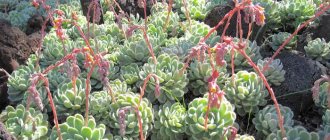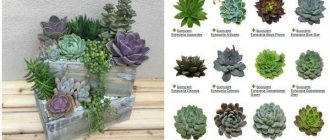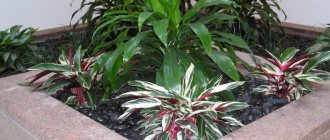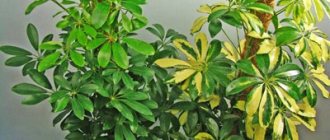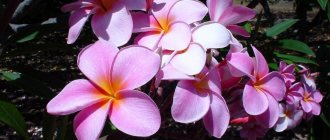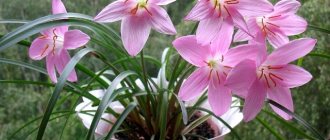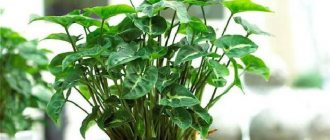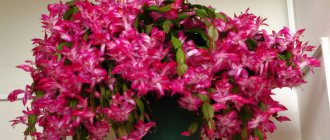Many gardeners love to grow exotic plants at home. One of these interesting representatives of the flora is Echeveria. People call it stone rose.
Its unusual appearance and coloring made it an indispensable inhabitant for alpine slides and multi-level flower beds and for home window sills. But before planting, you should familiarize yourself with the types and varieties of Echeveria, photos are presented below.
general information
Echeveria is a perennial succulent and a close relative of the Crassula plant. In nature, it most often grows in Mexico, but in our country it is grown as a houseplant and for decorating alpine slides.
The small massive stem is almost indistinguishable under the dense rosette. Neat but fleshy leaves are collected into a kind of inflorescence, and for this feature Echeveria is nicknamed the stone rose. Most often, the leaves are oval, with a sharp tip.
Sometimes echeveria blooms, and does so very intensely and for a long time. Then it produces thin peduncles with many small bells. With proper care, you can achieve repeated flowering.
Photo: vkusnosushi.ru
Echeveria species
There are so many types of echeveria that they are classified according to dozens of characteristics. For example, by the size, shape or color of the leaves, by the type of root system, by sensitivity to light, by the structure of the rosette. Let's look at a few of the most common ones!
Agave echeveria
It really resembles a small agave, and also an open water lily bud. The leaves are red, and the intensity of the color varies depending on the time of year.
Photo: aloli.ru
hump-flowered echeveria
It is a bit like a tree in its structure with distinct branches. It is on these branches that large bluish rosettes of irregularly shaped leaves are formed.
Photo: oir.mobi
Echeveria Affinis
A very tiny succulent with very dark, almost black leaves. But when there is a lack of light, the compact fluffy rosette stretches out and brightens.
Photo: pinterest.ru
Metal-flowered echeveria
A very decorative appearance with an openwork edge of the leaves and an intense metallic tint. This echeveria hardly blooms at home, but it is good anyway.
Photo: landscapeportal.ru
Graceful Echeveria
This species does not have a main stem at all, and the rosette actually grows directly from the ground. The leaves are medium in size, up to 5 cm in length, and bluish-green in color. They are covered with thin fibers that cannot be gotten rid of.
Photo: distano.ru
Scarlet Echeveria
It is distinguished by the special shape of its leaves - hard, voluminous, with a sharp, prickly tip. Color – olive with burgundy and brown splashes.
Photo: fiftyflowers.ru
Echeveria Derenberga
This is a creeping species that is capable of growing with children no worse than a ground cover. The grayish leaves have a pink tint at the tips. This echeveria blooms early - by mid-spring with large yellow flowers.
Photo: public.fotki.com
Echeveria Lau
One of the most bizarre varieties with a thick trunk, equally thick peduncles and unusual buds. The entire plant, including the flowers, is covered with a waxy coating.
Photo: worldofsucculents.com
Stromantha (50 photos): types, planting and care at home
In open ground
Is it possible to plant a heat-loving southerner in open ground? Doing this is completely undesirable. The plant simply cannot withstand the harsh cold and will die. Flower growers advise initially growing seedlings (using the method described above).
When the echeverias are fully formed, they can be transplanted into open ground (approximately May-July). If an irresistible desire arises to plant seeds directly into the soil, then you need to do the following:
The selected area of land is poured with boiling water for disinfection.- The earth is being dug up.
- Wooden boards are sunk into the soil on all sides, which will serve as the basis for the future greenhouse.
- Sand, perlite, and coal are added to the soil.
- The soil is mixed.
- Seeds are poured onto the prepared substrate using a sheet of paper folded in half.
- Seedlings are watered abundantly with warm water.
- The top is covered with thick glass, which can provide greenhouse conditions for echeveria.
Echeveria care
Echeveria is an ideal succulent for beginners and for those who always forget about care. Regardless of the variety, it requires minimal human intervention for a long and comfortable life.
Temperature
The best summer temperature for echeveria is about 25 degrees, but in winter it easily tolerates much lower thermometer readings. 6-8 degrees is enough, and you shouldn’t increase them too much so that the socket doesn’t start to stretch.
Photo: zelenj.ru
Lighting
Echeveria needs a lot of light so that it grows a rosette neatly and beautifully. Moreover, this may well be direct sunlight. Perhaps some varieties should be shaded a little around noon on southern windows.
Photo: zen.yandex.ru
Watering
Echeveria is watered rarely and not very abundantly, otherwise the roots will begin to rot. Its leaves store enough moisture for dry periods, so it is always better to overdry than to overwater. We recommend watering the echeveria through a tray. There is no need to spray it either.
Photo: commons.wikimedia.org
The soil
Ready-made mixtures for succulents will solve all your problems. Or you can mix ordinary universal soil with sand and peat yourself.
Photo: zzseeds.com
Fertilizers and fertilizing
In the summer you can occasionally use fertilizer for succulents, but this is not fundamentally necessary. There is no need to fertilize the flowerpot too much, because the echeveria will begin to grow unevenly and become deformed.
Photo: komnatnyecvety.ru
Wintering
As we said, a cool, dry winter is desirable for echeveria. The fact is that at this time the plant is in dire need of light. And it is precisely because of this that it begins to deform. So it is better to ensure that Echeveria is in a kind of suspended animation until spring.
Photo: vseshokeri.ru
Transfer
In spring, echeveria is carefully replanted so as not to damage the leaves, and especially the plaque or fibers on them. At the same time, you need to inspect the roots for damage and rot, and, if necessary, treat them with charcoal. The flowerpot needs to be compact and shallow.
Photo: haworthias.ru
Pachistachis (50 photos): types, planting and care at home
Bloom
Varieties of echeveria that throw out arrows are ready to bloom up to 2-3 times a year . But the formation of buds occurs only in favorable conditions. Some succulent lovers are not interested in flowering , so when the plant forms shoots, they remove them.
To provoke budding of a succulent, it is worth extending the daylight hours . To do this, you must fulfill the following conditions of detention:
- The room temperature should be +16..+180C;
- The duration of exposure to sunlight on the bush is up to 12-13 hours;
- Keeping in such conditions for up to 45-50 days.
Only then can you get the desired result and admire the buds . If the plant blooms, it is recommended to increase watering and apply fertilizers containing nitrogen, potassium and phosphorus.
In this video you will see blooming echeveria and several of its species.
Thus, there are many varieties of echeveria. Rarities include Topsy Torvy, Rainbow, Globulosa and Peacock. Each variety has a special structure and structure of the plates . Therefore, many gardeners create entire greenhouses from species of this succulent.
Reproduction and planting of echeveria
The most convenient way to propagate echeveria is by leaves and cuttings, and practically nothing is needed for this. The cuttings are immediately rooted in the ground without any additional steps. The leaves must first be dried for at least half a day, and then stuck into the ground in the same way. Within a week the roots will begin to grow.
For long-stemmed species, shoot tips can be used. And the squat ones reproduce well by children - basal rosettes. They just need to be carefully separated and planted.
Photo: design-homes.ru
If the stem is stretched or the leaves are wrinkled, we eliminate errors in care
| Problem | Symptoms | Solution |
| Lack of light | Stretching of shoots, loss of decorative effect | Place it on the lightest windowsill, provide illumination with fluorescent lamps or phytolamps. |
| Lack of moisture | Leaves are limp, wrinkled | Increase watering. |
| Aging | Yellowing of lower leaves | This is a natural process in the life of a flower - remove them as they dry. |
| Excess moisture | Leaves are swollen, watery, yellow | Urgently inspect the roots and soil, replant the flower in suitable air-intensive soil, and adjust watering. |
Pest and disease control
Succulents have strong immunity, and echeveria is no exception. Very rarely it is affected by aphids or mealybugs, and insecticides will help you here. But it is better to abandon traditional methods so as not to damage the leaves by mechanical influences.
Otherwise, everything depends on care. If the leaves turn black or become stained, it means they have been exposed to water or have a fungus. In any case, the problem is excessive humidity and low temperature. Use fungicides and stabilize conditions quickly.
Photo: st-georgerealestate.com
Schefflera (50 photos): types, planting and care at home
Home growing conditions - table
| Parameter | Winter autumn | Spring Summer |
| Lighting | Bright light, direct rays, do not place on north-facing windows. | |
| Watering | Moderate, no more than once a month | After the earthen clod has completely dried, once every 10 days |
| Air humidity | Does not require spraying the outlet | |
| Temperature | Cool room with a temperature of at least 10 degrees Celsius | 22–27 degrees |
Echeveria – photo
Only at first glance, echeveria may seem completely unremarkable and banal. But in fact, they are all special and unique!
Photo: pinterest.ru
Photo: pinterest.fr
Photo: mykaleidoscope.ru
Photo: tr.pinterest.com
Photo: commons.m.wikimedia.org
Photo: pinterest.ru
Photo: pinterest.co.uk
Photo: komnatnyecvety.ru
Photo: tripchik.ru
Photo: cvetkoffandbuketoff.ru
Photo: cactusgarden.ru
Photo: jdhager.wordpress.com
Photo: pinterest.ru
Photo: fastbox.su
Photo: aloli.ru
Photo: na-dache.pro
Photo: pixabay.com
Photo: gardenista.com
Photo: succicrafts.com
Photo: succicrafts.com
Did you like the post? Subscribe to our channel in Yandex.Zen, it really helps us in our development!
